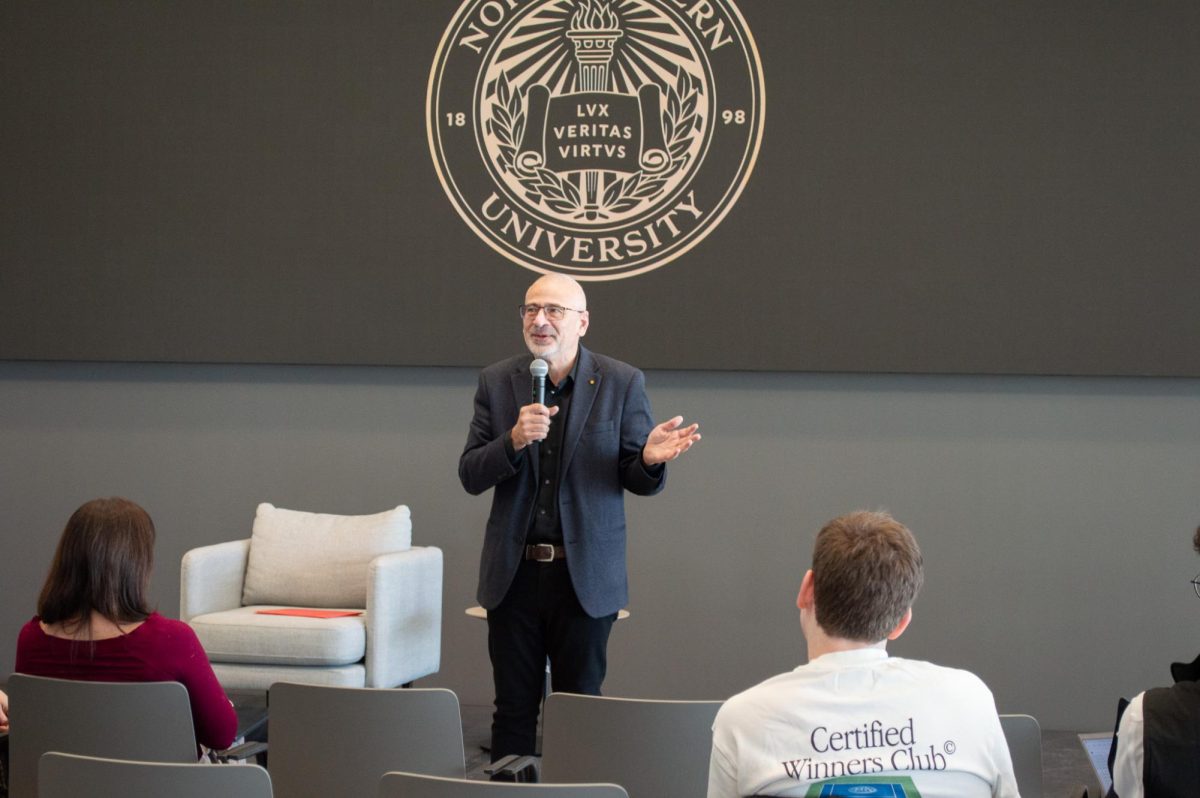Meet Sim Man. Most nursing students already have. This $35,000 life-like patient is housed within the recently erected walls of the Behrakis Building, and is giving students an unusual approach to learning.
Sim Man, a human patient simulator created by Laerdal Medical, was purchased by Northeastern during the summer of 2001 with a grant to the School of Nursing. This talking, breathing, automated mannequin has a heartbeat, pulse and chest movements, and it can also making vomiting noises, moan in pain and receive injections.
And he’s not alone. According to Brenda Douglas, an assistant clinical specialist for the nursing school, Sim Man has a whole family of human patient simulators at Northeastern.Noelle, a $3,000 automated simulator made by the Gaumard company, was purchased this fall and simulates childbirth for a class called Healthy Child. Two more bundles of joy are on the way, including a $2,000 infant and a $1,400 six-year-old child, both made by Laerdal Medical. The two pediatric models should be in by winter quarter 2003.
The purpose of Sim Man and friends is to provide practice for students in a controlled environment monitored by a professor through a computer program.
“It basically looks like a sleeping person,” said sophomore nursing major Amanda Turner.
Turner worked on Sim Man about five times last year as a freshman in a three hour lab she had for a health assessment class. Her classroom exercises included distinguishing a regular heartbeat from a heart murmur and checking a pulse.
“It’s a good starting tool,” she said. “At first, everyone is scared to treat a real patient, so it makes you a lot more relaxed.”
The nursing school at Northeastern understands the apprehension faced by first time nursing students. Dean of Nursing, Nancy Hoffart, encourages this safe environment where students can learn medical techniques on a patient that cannot feel pain.
“It really helps students develop instead of putting them in a really difficult situation where you walk into a room and a patient has many things going on. Unless you’ve faced each of those things individually it’s really hard to determine, ‘Where do I start here?’ and ‘What is the most critical piece of information?'” she said.
Hoffart likes the piece-by-piece mastery of skills that Sim Man can offer, as well as the opportunity that students get to repeat these skills over and over again until they feel comfortable enough to perform them on actual living patients. In the real world, students would only get one chance.
Turner said it was easier for her to find a blood pressure reading on the Sim Man than it was to find one on her friends, since teachers program an exact blood pressure level and know, without error, whether a student is right or wrong. On a real patient, Turner explained that the level might change within the five minutes it took for a teacher to check a student’s answer.
“I can make [Sim Man’s] pulse anything I want,” said Douglas. “If I set his pulse at 80, I can tell right away whether students know what they’re doing or not.”
Another advantage to having these automated patients is the ability to create situations that would not ordinarily occur in the classroom. A student can listen to Sim Man to tell the difference between what a patient’s breath sounds like with asthma, bronchitis, and pneumonia. Practicing on classmates doesn’t give the same variance.
“The wonderful part about it is that in a class, everyone usually is within the range of normal,” said Douglas.
However, Turner mentions a significant thing Sim Man lacks; real life interaction.
“It doesn’t talk to you like if you were [practicing] on your friends. You’re learning, but at the same time it’s almost a joke,” she said.
This year, Turner has moved on to working with real patients in a clinical class she is taking, and said that the one thing that Sim Man is really good for is reassuring a student’s confidence when it comes down to doing it for real.
Another down side of the automated machines are technical problems.
“[Sim Man] is high maintenance, and you have to keep him clean,” said Douglas. “He has technical problems, and it’s something that we have to work through. The more you work with the mannequins and the more familiar you are with them, the less the problems happen.”
Despite a few of these technical issues, Douglas said for the most part that company tech. support personnel have been more than just helping, giving personal cell phone numbers for solving problems and even sending a free compressor to replace a malfunctioning one.
In addition, students are instructed to wear gloves while working with the model to prevent dirt and stains caused by oils on the hand, said Douglas. Sim Man is also cleaned regularly with alcohol.
Human simulation is becoming more and more mainstream in medicine. The Alberta Shock Trauma Air Rescue Society (STARS) Human Patient Simulation Program is the first mobile simulator program in North America. Armed with a mobile home that travels around Canada and doubles as a makeshift emergency room, the project brings the human simulators to train people who would otherwise not have access to them. The human simulator they use has the ability to speak, dilate its pupils, move its chest while breathing, and show the symptoms and effects of treatment drugs.
In the United States these simulators are used for anesthesia practice, combat training through the Special Forces Medical Sergeants, and pediatric care. The Cincinnati Children’s Hospital even has a human patient simulator that looks and behaves like a 7-year-old.










